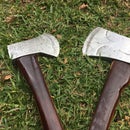Introduction: Wooden Leather Burnisher
After doing some serious leather work, I wasn't happy with the cut edges on what I was making. Normally I don't burnish edges because the sealant I use soaks into the edge and makes the edge very water proof. However for this particular project I am making I felt it needed it. I read on a few sites that burnishing can take hours sooo I did some thinking and thought " why not make a burnisher that fits on a Dremel, a fast burnisher!!!". I then did some YouTubing and found a video with a guy using one he bought. I designed mine differently to take three different sizes of leather. 1-2mm, 3mm and larger. It works great and takes only a few minutes to burnish quite a lot of leather. I hope you guys enjoy.
Step 1: Things You Need
First I bought a timber curtain rod end and cut the base sides off so that it does not roll away when put on a bench or piece of marble. It will look like.. . . .. ... LOL ...UM well ya know. Next get some 3mm or 1/8th braising rod. This is very cheap from a hardware store, I had some laying around so I cut a small piece about 50mm or 2 inches.
Step 2: Drill Base
Next Put a 1/8th or 3mm drill in your Dremel and make a hole as straight as you can in the base of the curtain rod.
Step 3: Mix Glue
Next mix up some Araldite and swirl it around the braising rod and put it in the base even drip some in.
Step 4: Let It Dry
Let this sit for 24 hours - don't jump the gun on this step. I also filled a crack that was in this timber with the glue.
Step 5: Trim Braising Rod
Then with wire cutters, cut the base off the rod so it fits most of the way into the Dremel drill, then sand smooth.
Step 6: Cut Lines
Next use a hacksaw to cut in lines on the timber where you want to have your grooves. Do this by turning on the Dremel and slowly touching the hacksaw teeth to the timber bit you have made.
Step 7: Shaping
Next use the hacksaw as a lathe tool to shape the timber while the Dremel is going. You could use a rats tail file for this if you have one or even really heavy-grit sandpaper. I turned the hacksaw on an angle to open up the grooves.
Step 8: Sand It
I then I used sandpaper to clean the grooves out. Follow this with 600 grit wet and dry paper to smooth out the grooves and surface. I changed this later by opening the grooves to be more concave, although it created a very cool V shape on the edges at first.
Shape it according to what you want your leather edges to look like.
To use this, wet the leather with water and then burnish. No products required.






